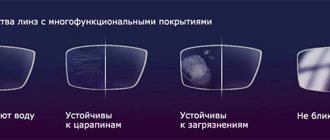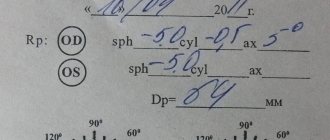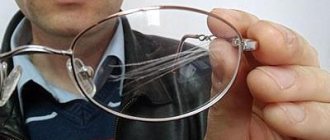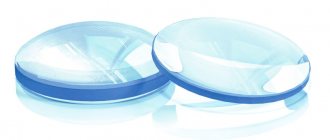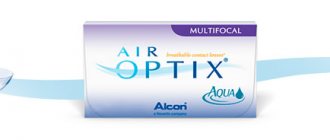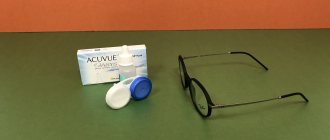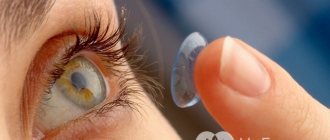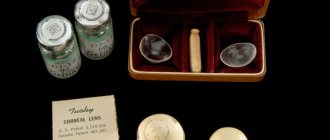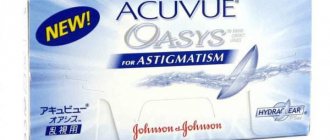Every person who has vision problems and wears glasses wants them to fulfill their main purpose and look beautiful on their face. However, it is difficult to achieve aesthetics in case of serious pathologies, at the last stage of myopia or farsightedness, since the glasses are thick and strongly stick out from the frame. Ophthalmologists listened to the complaints and wishes of patients and aspheric lenses for glasses were born. They are characterized by unusual curvature and intricate geometric shapes, making their surface thinner and flatter.
What it is?
Classic glasses for glasses have a spherical surface, the main optical power is concentrated in the center. Accordingly, a person receives a clear and contrasting picture only in this visual area; visibility is much lower at the edges. The diameter of the zone is about two and a half centimeters, with a viewing angle of ten degrees. To obtain a good image, a person needed constant concentration on this area, which creates additional stress on the visual system.
Why have such imperfect products been at the peak of popularity for so long? There are two simple reasons for this:
- For a long time, the field of optics practically did not develop; no innovative solutions were created in this area;
- There was no need for unique lenses because people wore glasses with small frames, in which the existing optics looked appropriate.
However, time passes, people and their desires change. Large frames appeared on store shelves and classic “spheres” could not 100% satisfy the needs of a person with vision problems.
| The aspherical lens is thin and provides a full-fledged image over the entire surface of the glass. Ophthalmologists achieved a similar effect by changing the curvature and selecting high-quality materials. For production, cast glass is used, produced using a unique technology. |
Unique Features of SEIKO Aspherical Lenses
Aspheric lenses for glasses have a number of significant advantages over spherical ones. Their design allows for a significantly wider field of vision, especially around the periphery of the glasses and this is important for high diopters. An additional bonus of the aspherical surface design is the thinner (about 7-10%) thickness of the spectacle lens, which in turn reduces the weight of the finished glasses. Often, due to the complexity of the design, there is an amateur opinion among medical glasses users that aspheric lenses may not “fit.” The problem of adaptation to aspherical lenses is completely solved by the patented Japanese technology SEIKO MX-Design, which guarantees a natural feeling of vision in glasses.
Go to the “Eyeglass Lenses” page.
It is important to keep in mind that aspheric lenses, due to their design features, must be installed clearly in accordance with the markings of the centers of the pupils. The values of RC (center-to-center distance between the pupils) and the height of the center of the pupil in the frame of the frame must be observed. The ease of adaptation to new spectacle lenses largely depends on this. Usually it takes a short period of getting used to the aspherical design, because when wearing glasses with such lenses, the user receives a completely new image built on a different principle.
Even if the position of the medical frame on the face is fully taken into account, it is not in a stationary state when worn - there are always minor displacements and movements of the frame, leading to a displacement of the optical center of the lens relative to the eyes. In this case, the user may experience discomfort (floating effect, dizziness). The Japanese company SEIKO Optical has given its answer to this challenge. A special aspherical lens design was developed and patented, which neutralizes the consequences of deviation of the optical axis from the centers of the user’s pupil - SEIKO MX Design.
The main idea of the patent is that a special 10mm spherical core, which is naturally perceived by the human eye, is installed in the optical center of the aspherical lens. This creates a central vision area that takes into account possible deviations in the installation of lenses and the instability of the position of medical glasses on the user’s face. This approach gives SEIKO brand lenses 100% satisfaction from use! It is thanks to the MX Design that SEIKO Optical provides a 100% factory guarantee for spontaneous adaptation to its aspherical lenses. The same patent applies to SEIKO bi-aspheric lenses (SEIKO AZ-Design Double Aspheric).
We confidently recommend buying SEIKO aspherical lenses to all our clients, both elderly and young people. Spontaneous and natural adaptation is guaranteed by the manufacturer. Rest assured that the image clarity, aesthetic thinness and lightness of aspherical lenses are worth it!
Photo: seiko-optical.de
What to choose - aspherical or spherical lenses?
To get the answer to this question, just compare the products. The main difference is their surface. The “vintage” version is designed in such a way that the lens is spherical on both sides, and therefore has an identical viewing radius over the entire area. “Modern” glass is designed differently:
- In appearance they resemble a parabola or an oval;
- When viewing through them there is practically no distortion of the picture;
- The special shape expands the radius of visual vision.
This is all how spherical lenses differ from aspherical ones? At first glance, it seems that the difference is not significant. But that's not true! Spherical lenses are very thick and in the low diopter range they have a negative impact on appearance. The eyes increase in size, the face seems disproportionate, and for many this causes significant discomfort and causes psychological stress.
Aspheric lenses eliminate this problem due to their unique structure. Of course, there will be distortions when using them, but they will be insignificant. They are thin and easy to use; a small amount of material is used to create the product, which is appreciated by optics manufacturers.
Each person decides for himself which option to choose, but in terms of aesthetics and comfort, no other product today competes with aspherical glass. Return to contents
What are aspheric contact lenses?
Ophthalmic products of this type allow you to effectively correct visual aberrations due to their design. The design of aspherical contact lenses has certain features. The back or front surface of the product has the shape of an ellipse.
Specialized aspherical contact lenses are distinguished by a radius of curvature that varies from the center to the edges. Increasing this parameter helps to effectively neutralize ocular aberrations and reduce their severity. The use of aspherical lenses significantly increases contrast sensitivity. Also, aspheric profile contact lenses are characterized by the elimination of distortions that are caused by the optics themselves. Therefore, aspherical lenses provide clear, distinct, contrasting perception of surrounding objects.
Advantages
To understand the reason for the popularity of the product, check out their advantages:
- Spherical glasses have a negative impact on visual contrast because the optical power is unevenly distributed. Their “rival” allows for high contrast;
- Wide range, the ability to choose the material for production. You can order the production of lenses to correct all possible pathologies, including myopia, farsightedness or astigmatism. It is also possible to apply tinting or special filters;
- Comfort during use due to its small thickness and lightness;
- When using a “sphere”, patients often experience discomfort due to aberrations, since the edges of the image are unclear and distorted. People often complain of headaches and nausea. The problem is aggravated if a person has pathologies of the lens or cornea. Aspheric lenses do not have this disadvantage;
- Another important factor is aesthetics. The glasses, common since Soviet times, are thick and protrude unattractively from the frame, distorting the contour of the face. The new ophthalmology product is distinguished by its subtlety and looks elegant even with advanced myopia or farsightedness.
After watching the video, you will learn how “classic” differs from “modern”
The difference between spherical lenses for glasses and aspherical ones
The difference between the two types of spectacle lens designs can be divided into two parts - the structural difference in the geometry of the lens and the properties that users receive.
If we talk about geometry, an aspherical lens is flat on one side, internal or external, while a spherical lens has the shape of a crescent. There are also lenses with double aspherics - bi-aspherical. The main thing, in our opinion, is what the user of glasses gets with certain lenses.
Among the main differences between a spherical and aspherical lens are:
- an aspheric lens has less aberrations at the edges;
- the eye size looks more natural with large diopters;
- with the same prescriptions and refractive indices, an aspherical lens will always be thinner than a spherical one;
This is the difference between a spherical and an aspherical lens.
What benefits do you get if you buy spherical lenses for glasses?
- excellent optical properties;
- 100% adaptation guarantee;
- lower cost;
- possibility of ordering sports-type frames;
Disadvantages of aspherical lenses
Despite all the positive aspects of optics, it has several disadvantages:
- High-quality and expensive materials and modern technologies are used for production, so the products are more expensive than ordinary glass. But there is no need to save on health; if handled correctly, they will last for a long time and compensate for all expenses;
- When using glasses with aspherical lenses, patients periodically encounter problems such as glare and light reflection. But it’s easy to solve, just apply an anti-reflective coating to the glass. This “trick” is very useful for drivers who drive in the dark, as well as for those who spend the whole day in front of a computer monitor.
The coating will certainly be appreciated by selfie lovers; you will look good in the photo. When wearing classic glasses, the eyes are most often not visible in the photograph.
| The disadvantages of the composition include the fact that the glass becomes vulnerable to scratches and stains, so you will have to wipe them more often with a clean cloth. |
Return to contents
Spherical lenses
Spherical lenses are the easiest way to correct lower-order aberrations associated with imperfections in the optical system of the eye - myopia, hypermetropia and astigmatism. Such aberrations are diagnosed by an ophthalmologist during a vision test and corrected with spherical, astigmatic glasses or spherical toric contact lenses. Thus, although spherical lenses correct or correct the main visual defects: myopia, hypermetropia and astigmatism to complete correction, but having their own spherical aberrations, they cannot provide sufficient clarity and contrast of vision. In this case, higher order aberrations become noticeable only if lower order aberrations are completely corrected.
Higher order aberrations are spherical aberrations and chromatic aberrations.
Spherical aberrations are distortions inherent in spherical lenses, both spectacle and contact lenses, which is the same as in the human eye.
Light rays passing through the entire surface of a spherical lens are not equally focused on the retina, forming circles of light scattering, which leads to a blurred image. Spherical aberrations are more noticeable in spectacle lenses, especially when looking sideways. It has been established that the average value of spherical aberrations of the human eye, provided visual acuity is 100%, is 0.12 diopters. This can significantly affect the quality of vision.
| Spherical contact lenses | |||
| Daily use spherical lenses | Two-week spherical lenses | Monthly spherical lenses | Quarter spherical lenses |
| 1-Day Acuvue Moist Acuvue TruEye Dailies Total 1 Acuvue Define Sparkle Acuvue Define Shimmer Biotrue One Day Acuvue Moist for Astigmatism Proclear 1 day Biomedics 1 Day Extra | Acuvue Oasis Acuvue Advance Acuvue 2 | Soflens Comfort 59 FreshLook Dimensions FreshLook Colorblends FreshLook Dimensions Plano FreshLook Colors Biomedics 55 UV Proclear Maxima 55 UV | Optima FW Soflens Natural Colors Ophthalmix Colors Biomedics 38 |
Contact lenses
Modern methods of production innovations in ophthalmology allow the use of aspherical products not only for the creation of spectacle glasses, but also for the manufacture of contact lenses. Unlike outdated “ancestors”, they have a number of advantages:
- Clear peripheral vision, widening visual angle. Spherical products do not have this advantage and increase eye strain;
- Small thickness adds comfort during use. They will be appreciated even by those who previously ignored such an optical device;
- Unlike glasses, they do not need to be coated with an anti-reflective coating. You can drive a car or work on a laptop in them.
The main disadvantage of the products is their high cost; not everyone can afford them. Due to the short service life, the optics have to be changed frequently, and this is a serious blow to the budget. For this reason, patients faced with the need to correct visual function often prefer glasses with aspherical lenses.
How is the operation performed?
The implantation of an aspheric IOL is performed by an ophthalmic surgeon. First, he removes the natural lens, then, under the influence of an ultrasonic needle, the lens is crushed into several particles, which are modified into an emulsion. Finally, it is aspirated (suctioned out) for subsequent implantation of an aspheric IOL.
For pain relief, anesthetic drops are instilled into the patient. They are safe and, unlike general anesthesia, do not affect the activity of the cardiovascular system. The entire surgical process lasts no more than 15-20 minutes. After the operation, the patient does not need to stay in the hospital; he can return home on the same day.
How to choose
An ophthalmologist should choose a lens. Before writing a prescription, the doctor conducts a series of necessary tests to determine visual acuity, identify existing abnormalities and susceptibility to diseases. For example, if there is a risk of cataracts, the doctor prescribes chameleon glasses. The ophthalmologist also determines the width of the lens and selects a frame for everyday use that will not cause discomfort when worn.
Consultation with a specialist will help the patient decide on the material used to make the optics and the manufacturer’s brand. If a person wants to choose contact lenses rather than glasses, the curvature of the cornea and the diameter of the pupil are examined, and these parameters are necessarily prescribed in the prescription.
Next, pay a visit to an optical salon and, based on the recommendations received, select a frame and order glass production. Don't forget to indicate which filters you want to install, and whether or not dimming is required. The product will be ready within two days.
| At first, you may experience discomfort and dizziness when wearing it, but this is normal. The body adapts to the new “accessory” in two weeks. |
Video about installing an aspheric intraocular lens
In the medical department, patients can undergo examination using modern diagnostic equipment, and based on the results, receive a consultation with a doctor. The clinic is open seven days a week and operates daily from 9:00 to 21:00. Our specialists will identify the cause of vision loss and treat the identified pathologies.
Our clinic provides consultations to the best ophthalmologists with more than twenty years of experience and 10 thousand successful treatments and operations.
You can make an appointment at the Moscow Eye Clinic by calling Moscow and (499) 322-36-36 (daily from 9:00 to 21:00) or using the online registration form.
Dagaev Adam Huseinovich

